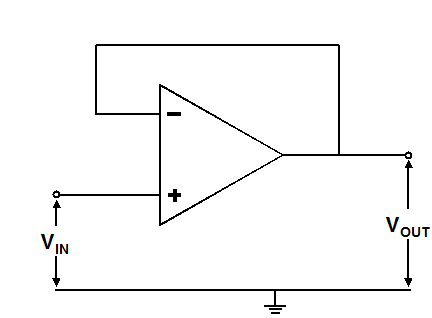The unity gain follower:
The somewhat lengthy term operational amplifier will now be dropped and it will be referred to, as most people do, simply as the op amp. The simplest op amp with feedback configuration is the unity gain follower, which has a direct connection from output to inverting terminal, and the input is applied to the non-inverting terminal as shown in Figure. For convenience, power supplies will not be shown in these circuits.

Consider the circuit in Figure 4 and assume that vin is a small positive dc voltage. With its enormous gain the output will probably saturate positive as soon as vin is applied. But the output is connected directly to the input inverting terminal, and being much greater than vin will drive the output to saturate negative, which is fed back to the input inverting terminal to drive the output to saturate positive again. It would appear that the output voltage is slamming from positive saturation to negative saturation and back again at a rapid rate. This of course is not the case at all, since in its travel from one extreme to the other, the output will arrive at the same value as the input, and when this is fed back to the inverting input terminal, the input difference voltage will be zero and there will be no signal to amplify. Thus vout holds a value equal to vin.
What has happened here is very important, since it applies to all op amps with negative feedback circuits, and it should be noted that feedback from the output to the inverting input terminal causes the output to take on a value which reduces the input difference voltage to zero.
Since the output of the unity gain follower is the same as the input, it may, on first consideration, have no practical application. As previously stated, even if the feedback caused the output to equal the input, the input and output impedances remain vastly different. Herein lies its practical application, as an impedance matching device, and it serves as an excellent 'buffer' stage preventing interaction between a signal source and load.